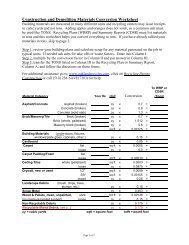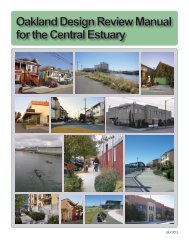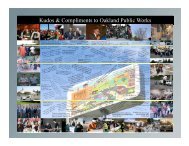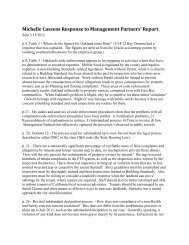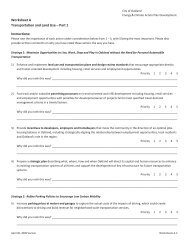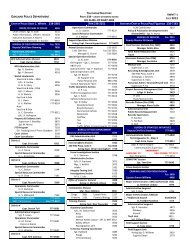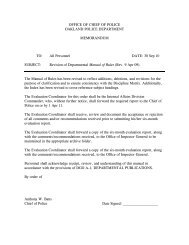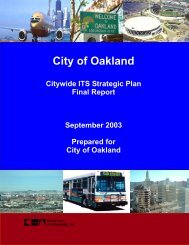Architectural Salvage Assessment, Contributing ... - City of Oakland
Architectural Salvage Assessment, Contributing ... - City of Oakland
Architectural Salvage Assessment, Contributing ... - City of Oakland
Create successful ePaper yourself
Turn your PDF publications into a flip-book with our unique Google optimized e-Paper software.
2. HISTORICAL OVERVIEW<br />
Commissioned in 1941, the <strong>Oakland</strong> Army Base played an important role over a 50‐year<br />
period as a supply depot and repair facility in World War II, the Korean War, the Vietnam<br />
War, and the Persian Gulf War (Desert Storm). Design and development <strong>of</strong> the base began<br />
in the spring <strong>of</strong> 1941, during the nation’s mobilization for World War II, and was largely<br />
brought to completion by the summer <strong>of</strong> 1942, at the height <strong>of</strong> the war. It was one <strong>of</strong> four<br />
U.S. Army facilities in northern California—with Fort Mason in San Francisco, Fort<br />
McDowell on Angel Island, and Camp Stoneman on the Sacramento River—known<br />
collectively as the San Francisco Port <strong>of</strong> Embarkation (SFPE). In 1942, with the completion <strong>of</strong><br />
major construction at <strong>Oakland</strong>, the facility was <strong>of</strong>ficially named the <strong>Oakland</strong> Army Base.<br />
2.1 Site, Setting, Mission<br />
With the Naval Air Station Alameda (1940) and the Naval Supply Center <strong>Oakland</strong> (1941), the<br />
<strong>Oakland</strong> Army Base formed part <strong>of</strong> a phalanx <strong>of</strong> military installations on the East Bay<br />
waterfront that opened on the eve <strong>of</strong> America’s entry into World War II. The similar Army<br />
and Navy complexes on <strong>Oakland</strong>’s western shoreline had identical missions: to funnel<br />
supplies to U.S. military operations in the Pacific. Rapidly built during wartime, both bases<br />
functioned as military ports, and both contained enormous warehouses, dockside transit<br />
sheds, and wharves served by rail lines, surface roads, and deepwater berths.<br />
The principal difference between the two installations was that whereas the Navy base was a<br />
self‐contained facility built from scratch, the Army facility combined new construction with<br />
existing industrial buildings on the site and also made use <strong>of</strong> the Port <strong>of</strong> <strong>Oakland</strong>’s extensive<br />
Outer Harbor terminal complex. 1 A portion <strong>of</strong> the site was occupied by the remnant <strong>of</strong> a<br />
World War I shipyard, built in 1918–19 by the Union Construction Company; the Army<br />
incorporated two <strong>of</strong> the shipyard buildings, including a large plate shop and mold l<strong>of</strong>t, into<br />
its installation.<br />
<strong>Oakland</strong> was the largest and most complex <strong>of</strong> the SFPE cargo‐handling facilities. One <strong>of</strong> the<br />
most fully integrated Army installations <strong>of</strong> its kind in the nation, the base combined various<br />
modes <strong>of</strong> transportation (ships, trains, and trucks) into a unified operation. The<br />
infrastructure included wharves, berths, a rail yard, tracks, roads, and storage yards. Trains<br />
and trucks brought in materiel from across the country to seven huge warehouses, each<br />
enclosing over five acres <strong>of</strong> floor space. Goods were transferred from the warehouses to<br />
dockside transit sheds in preparation for loading cargo ships. Ship repair shops were<br />
clustered near the shoreline, and miscellaneous other support facilities were scattered<br />
around the base. SFPE divisions housed at OARB during World War II included the Oversea<br />
1<br />
The <strong>Oakland</strong> Army Base controlled the Port <strong>of</strong> <strong>Oakland</strong>’s Outer Harbor terminals from 1941 to 1950,<br />
when they reverted to the Port. The Navy base, which closed in 1998, was razed and redeveloped by<br />
the Port with container terminals, an intermodal rail and truck facility, and a shoreline park.<br />
9







